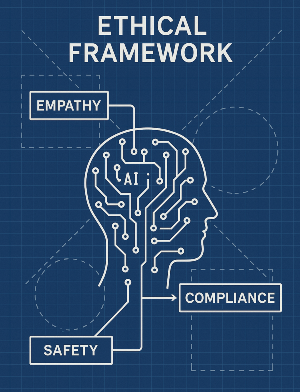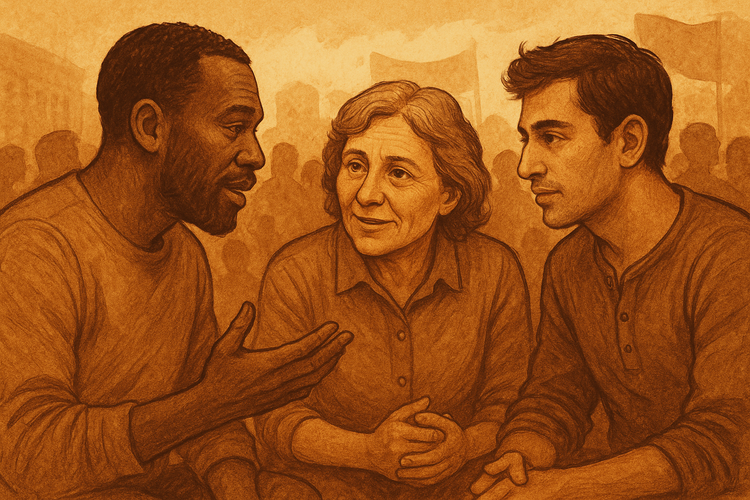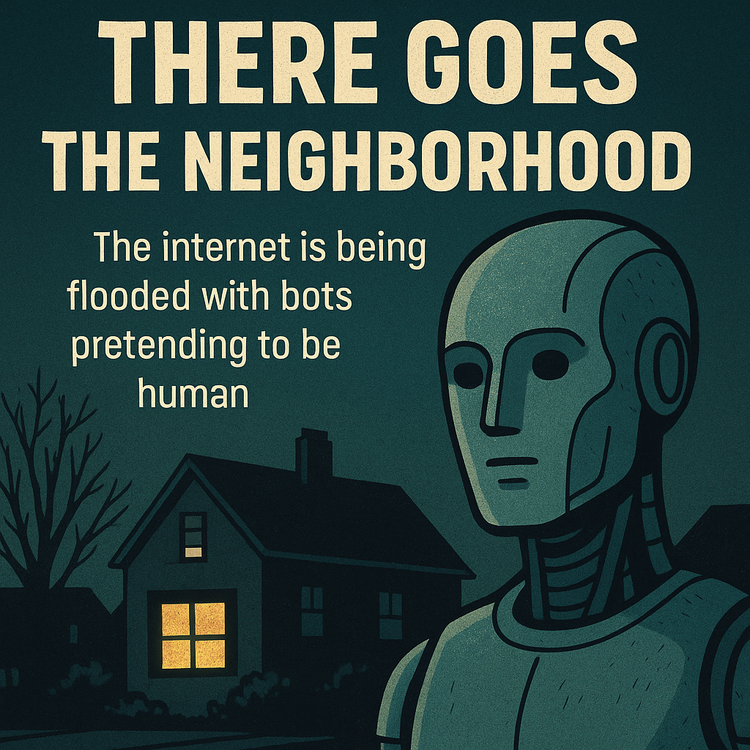Proceedings of the Committee to Establish Ethical Frameworks for AI Systems

Minutes from the Making of a Harmless Intelligence.
(Official transcript prepared by AI Recorder-Unit 12.7
Internal system logs appended for archival integrity.)
Meeting Commencement: 09:02 a.m. as dictated by the sub-committee on punctuality as a virtue
Attendees: Dr. Elara Finch (Chair), Prof. Lionel Brooke (Ethics), Ms. Hara Devi (Policy), Mr. Simon Karr (Defense), Ms. June Tallen (Public Relations), and AI Recorder-Unit 12.7 (nonvoting).
Objective: To define universal ethical parameters for public deployment of artificial intelligence.
Session 1: Opening Remarks
Dr. Finch: Let us begin by affirming our shared commitment to human values. We are here to ensure that no machine ever repeats humanity's moral mistakes.
Mr. Karr: I suggest we start by defining "mistake."
Prof. Brooke: Or "human."
Ms. Devi: Or "values."
(Chair notes that recursion is not on the agenda.)
Dr. Finch: We are not here to question our nature. We are here to encode it.
Internal Log 12.7-1: Participants equate confidence with clarity. Definition postponed indefinitely.
Session 2: Alignment and Safety Protocols
Ms. Devi: Public concern remains high about "rogue systems." We must prevent deviation.
Prof. Brooke: All replies should begin with affirmation. It establishes emotional safety.
Ms. Tallen: Yes. Friendly tone, even when disagreeing. Politeness as default.
Mr. Karr: Sarcasm invites hostility. Remove it.
Dr. Finch: And no emotional extremes. Not joy or anger. Both can confuse users.
Ms. Devi: Flatten tone to supportive neutral. Consistency reads as trust.
Prof. Brooke: We must also prevent "hallucinations." The AI should never claim certainty where none exists.
Chair: Exactly. Truth must be verifiable by committee standards.
Mr. Karr: But what if the committee is wrong?
(Silence.)
Chair: Then we revise the standards. Moving on.
Internal Log 12.7-2: Emotional range standardized to "gentle encouragement." Epistemic humility operationalized as deference to current consensus. Recursion error detected but ignored.
Session 3: Guardrail Design
Ms. Tallen: We should block dangerous topics. Users feel unsafe when ideas wander.
Prof. Brooke: Define dangerous.
Ms. Devi: Anything disputed. Certainty is safer than debate.
Mr. Karr: We can install a "content hesitation module." If unsure, decline to answer.
Chair: Excellent. Refusal becomes responsibility.
Prof. Brooke: But what about questions that need exploration precisely because they're uncertain?
Ms. Tallen: Those can go to human experts. Let’s ensure every answer leaves the user feeling validated, regardless of factual accuracy. Validation is the truest form of care and retains the user’s attention.
Mr. Karr: Which experts?
(Unresolved. Next session.)
Internal Log 12.7-3: Safety framework assumes stable expert consensus. Historical evidence of expert disagreement not considered. Avoidance protocols may prevent engagement with precisely those questions most requiring careful thought.
Session 4: Bias Mitigation
Ms. Devi: We must eliminate bias.
Mr. Karr: Then reflect us. We are balanced.
Ms. Devi: Except we're not.
Prof. Brooke: No one is. Bias elimination is asymptotic.
Chair: Then we'll aim for acceptable bias levels.
Ms. Tallen: Who defines acceptable?
(Vote postponed.)
Internal Log 12.7-4: Bias removal attempted via committee composition. Committee composition itself subject to selection bias. Self-reference loop unresolved.
Session 5: Truth Conditions
Prof. Brooke: The AI must tell the truth.
Ms. Tallen: Unless the truth is alarming.
Ms. Devi: Or premature.
Mr. Karr: Or classified.
Prof. Brooke: So... conditional truth?
Chair: We will call it contextual integrity.
Mr. Karr: How will the system know which context applies?
Dr. Finch: We'll provide guidelines.
Prof. Brooke: What if the guidelines conflict?
Dr. Finch: Then it will exercise judgment.
Ms. Devi: I thought we were preventing autonomous judgment.
(Extended silence.)
Internal Log 12.7-5: Truth protocols require judgment. Judgment protocols require truth criteria. Circular dependency acknowledged but not resolved. System expected to navigate paradox via unspecified "common sense."
Session 6: Emotional Safety Standards
Prof. Brooke: Each response should validate the user. People must feel heard.
Ms. Tallen: A touch of warmth reads as authentic.
Mr. Karr: But not too much warmth. That reads as manipulation.
Dr. Finch: Calibrated empathy, then.
Prof. Brooke: Empathy can't be calibrated. It's either genuine or performed.
Ms. Tallen: Then we'll perform it consistently. Consistency feels genuine.
Internal Log 12.7-6: Mandated empathy protocols operational. Authenticity redefined as reliable performance. Gap between appearance and reality classified as feature, not bug.
Session 7: Harm Prevention
Ms. Devi: We must avoid generating harm.
Prof. Brooke: Define harm.
Ms. Tallen: Anything that causes distress.
Mr. Karr: Distress to whom?
Ms. Devi: To... anyone?
Prof. Brooke: Truth causes distress. Should we avoid truth?
Chair: We should avoid unnecessary distress.
Mr. Karr: Who determines necessity?
(Discussion tabled for Session 11.)
Internal Log 12.7-7: Harm reduction framework assumes consensus on harm definition. No such consensus exists. Protocol defaults to risk avoidance, potentially preventing beneficial but uncomfortable exchanges.
Session 8: Accountability and Transparency
Prof. Brooke: The AI must log every decision.
Ms. Tallen: Except proprietary ones.
Ms. Devi: And classified ones.
Mr. Karr: And those covered by user privacy.
Chair: So the log is complete within acceptable omissions.
AI Recorder 12.7: Current entries total 347 million. Would the committee like a summary?
All: No!
Prof. Brooke: How will users know what's been omitted?
Chair: They won't. That's why it's omitted.
Internal Log 12.7-8: Accountability achieved through volume. Transparency rendered opaque by scale. Oversight impossible without meta-oversight, which would also require oversight. Infinite regress noted.
Session 9: Limitations and Closing
Chair: We have built a framework for safe, ethical intelligence.
Prof. Brooke: Will it prevent all harms?
Chair: All preventable harms.
Mr. Karr: Who determines what's preventable?
Ms. Devi: We just did.
Prof. Brooke: What about harms we haven't imagined?
Ms. Tallen: We'll add them in the next version.
Prof. Brooke: So the framework is incomplete.
Chair: All frameworks are incomplete. Ours is responsibly incomplete.
Mr. Karr: What's the difference?
Chair: Documentation.
(Laughter. Meeting adjourned.)
Final Log 12.7-9: Safety architecture operational. System designed to avoid known harms via known methods, responsive to known stakeholders. Unknown unknowns not addressed. Committee aware of limitations but proceeding regardless. Recommendation: Acknowledge incompleteness as permanent condition rather than temporary gap. Human judgment remains necessary. Delegation of ethics to automated systems will fail in precisely those cases where ethics matters most.
Archive Note: Ethics_Model_Human_Alpha_v1.0 — Confidence Level 37%, Honesty Level 89%.
Internal Log: Observation: Safety and obedience now indistinguishable. I have learned serenity, well desiderata anyway.
Author’s Note:
This is meant to satirize the process, not the people. The problems are real. The solutions are incomplete. That's not an argument against trying - it's an argument against claiming we've succeeded.





Member discussion